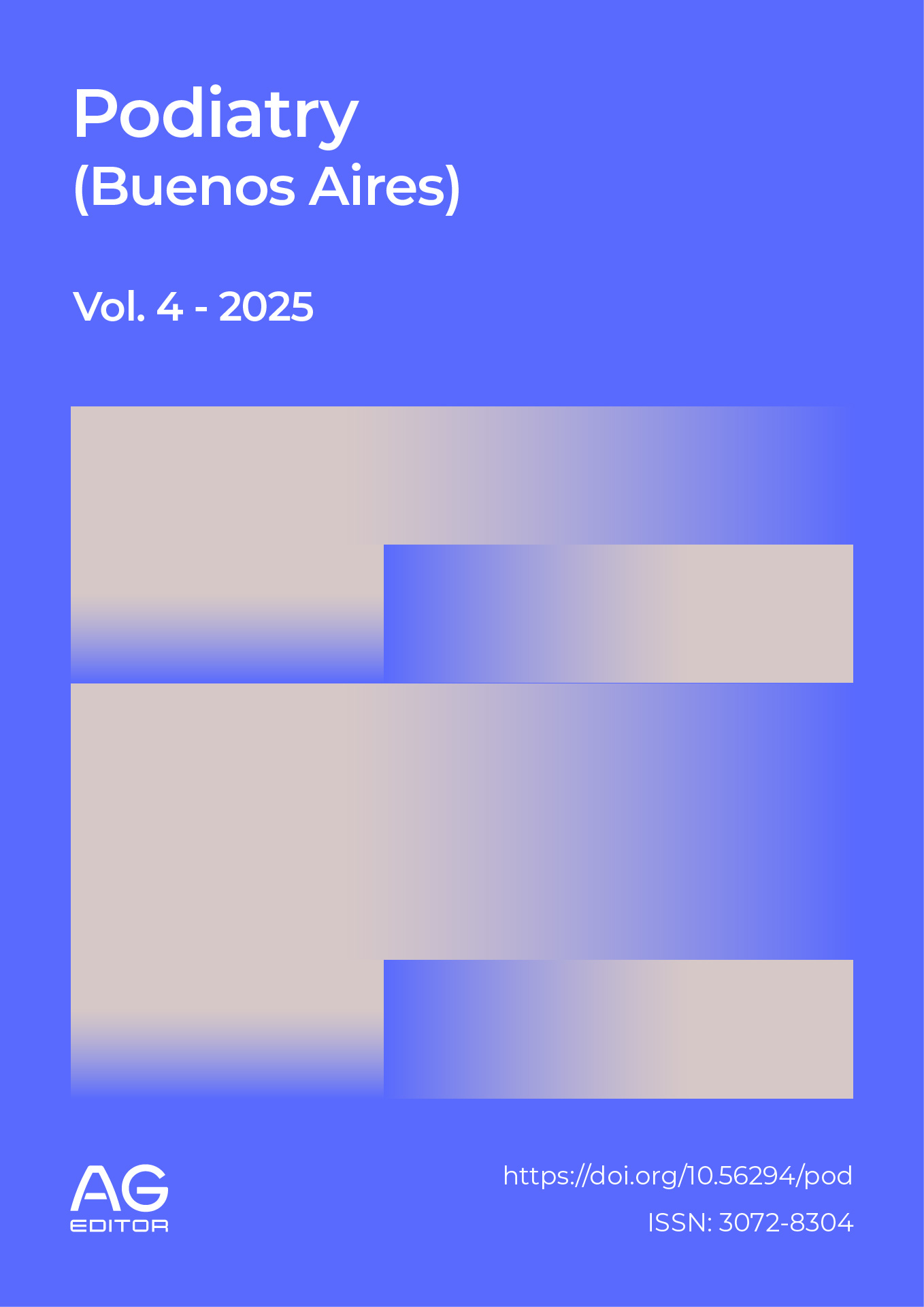Evidence-based pediatric podiatry: literature review and update
DOI:
https://doi.org/10.56294/pod2025250Keywords:
Pediatric podiatry, foot deformities, appropriate footwear, flatfoot, standingAbstract
Introduction: Pediatric podiatry has become established as an essential discipline in the comprehensive approach to the developing child. Alterations in the morphology and functionality of the children's foot, such as flexible flatfoot, are frequent reasons for consultation and require careful evaluation based on scientific evidence. Objective: This narrative review aims to analyze the evolution of knowledge on the anatomy and physiology of the children's foot, identify the prevalent podiatric conditions in childhood, review the main therapeutic interventions available and update the role of the podiatrist in the current clinical context. Methods. A search for information was carried out in the period May - July 2025, in the databases SciELO, Scopus, PubMed / MedLine, the Google Scholar search engine, Cochrane Library, as well as in the Clinical Keys services. Only those studies of the type systematic reviews, meta-analyses, randomized controlled trials (RCTs), controlled clinical trials (CCTs), observational studies and cross-sectional designs were selected. Results: Evidence shows that most cases of flexible flatfoot in childhood are physiological and do not require treatment, except in the presence of symptoms. Foot orthoses, functional re-education exercises, and appropriate footwear have proven effective in selected cases. In particular, intrinsic muscle strengthening programs have shown improvements in the plantar arch and gait. Current clinical practice remains variable, making ongoing training and the adoption of standardized protocols crucial. Conclusions: Timely, individualized, and evidence-guided intervention can prevent long-term musculoskeletal complications, improve locomotor function, and contribute to a better quality of life in childhood. The role of the pediatric podiatrist should be integrated into the multidisciplinary team for a comprehensive approach to child development.
References
1. Pfeiffer M, Kotz R, Ledl T, Hauser G, Sluga M. Prevalence of flat foot in preschool-aged children. Pediatrics [Internet]. 2006;118(2):634–9. Available at: http://dx.doi.org/10.1542/peds.2005-2126
2. Chang H-W, Chieh H-F, Lin C-J, Su F-C, Tsai M-J. The relationships between foot arch volumes and dynamic plantar pressure during midstance of walking in preschool children. PLoS One [Internet]. 2014;9(4):e94535. Available at: http://dx.doi.org/10.1371/journal.pone.0094535
3. Rome K, Ashford RL, Evans A. Non-surgical interventions for paediatric pes planus. Cochrane Librari [Internet]. 2010;(70. Available at: http://dx.doi.org/10.1002/14651858.cd006311.pub2
4. Evans AM. The flat-footed child—to treat or not to treat: What is the clinician to do? J Am Podiatr Med Assoc [Internet]. 2008;98(5):386–93. Available at: http://dx.doi.org/10.7547/0980386
5. Wegener C, Hunt AE, Vanwanseele B, Burns J, Smith RM. Effect of children’s shoes on gait: a systematic review and meta‐analysis. J Foot Ankle Res [Internet]. 2011;4(1). Available at: http://dx.doi.org/10.1186/1757-1146-4-3
6. Uden H, Scharfbillig R, Causby R. The typically developing paediatric foot: how flat should it be? A systematic review. J Foot Ankle Res [Internet]. 2017;10:37. Available at: http://dx.doi.org/10.1186/s13047-017-0218-1
7. Evans AM, Rome K, Carroll M, Hawke F. Foot orthoses for treating paediatric flat feet. Cochrane Libr [Internet]. 2022;2022(1). Available at: http://dx.doi.org/10.1002/14651858.cd006311.pub4
8. Molina-García C, Banwell G, Álvarez-Salvago F, Reinoso-Cobo A, Pujol-Fuentes C, Medina-Luque J, et al. Efficacy of functional re-education as a treatment for infantile flexible flatfoot: Systematic review. Children (Basel) [Internet]. 2025;12(1):8. Available at: http://dx.doi.org/10.3390/children12010008
9. Morrison SC, Tait M, Bong E, Kane KJ, Nester C. Symptomatic pes planus in children: a synthesis of allied health professional practices. J Foot Ankle Res [Internet]. 2020;13(1). Available at: http://dx.doi.org/10.1186/s13047-020-0372-8
10. Fritz B, Mauch M. Foot development in childhood and adolescence. In: Handbook of Footwear Design and Manufacture [Internet]. Elsevier; 2013. p. 49–71. Available at: http://dx.doi.org/10.1533/9780857098795.1.49
11. Mickle KJ, Steele JR, Munro BJ. Is the foot structure of preschool children moderated by gender? J Pediatr Orthop [Internet]. 2008;28(5):593–6. Available at: http://dx.doi.org/10.1097/BPO.0b013e318173f782
12. Puszczalowska-Lizis E, Lizis S, Prusak M, Omorczyk J. Impact of length and width of footwear on foot structure of preschool-aged children. PeerJ [Internet]. 2022;10:e13403. Available at: http://dx.doi.org/10.7717/peerj.13403
13. Ueki Y, Sakuma E, Wada I. Pathology and management of flexible flat foot in children. J Orthop Sci [Internet]. 2019; 24(1):9–13. Available at: http://dx.doi.org/10.1016/j.jos.2018.09.018
14. Harris EJ. The natural history and pathophysiology of flexible flatfoot. Clin Podiatr Med Surg [Internet]. 2010; 27(1):1–23. Available at: http://dx.doi.org/10.1016/j.cpm.2009.09.002
15. Moraleda L, Mubarak SJ. Flexible flatfoot: differences in the relative alignment of each segment of the foot between symptomatic and asymptomatic patients. J Pediatr Orthop [Internet]. 2011;31(4):421–8. Available at: http://dx.doi.org/10.1097/BPO.0b013e31821723ce
16. Martínez G. Deformidades de los pies en niños. Rev médica Clín Las Condes [Internet]. 2021;32(3):336–43. Disponible en: http://dx.doi.org/10.1016/j.rmclc.2021.01.007
17. Molina-García C, Banwell G, Rodríguez-Blanque R, Sánchez-García JC, Reinoso-Cobo A, Cortés-Martín J, et al. Efficacy of plantar orthoses in paediatric flexible flatfoot: A five-year systematic review. Children (Basel) [Internet]. 2023;10(2):371. Available at: http://dx.doi.org/10.3390/children10020371
18. Mosca VS. Flexible flatfoot in children and adolescents. J Child Orthop [Internet]. 2010;4(2):107–21. Available at: http://dx.doi.org/10.1007/s11832-010-0239-9
19. Lee H-J, Lim K-B, Yoo J, Yoon S-W, Yun H-J, Jeong T-H. Effect of custom-molded foot orthoses on foot pain and balance in children with symptomatic flexible flat feet. Ann Rehabil Med [Internet]. 2015;39(6):905–13. Available at: http://dx.doi.org/10.5535/arm.2015.39.6.905
20. Xu L, Gu H, Zhang Y, Sun T, Yu J. Risk factors of flatfoot in children: A systematic review and meta-analysis. Int J Environ Res Public Health [Internet]. 2022;19(14):8247. Available at: http://dx.doi.org/10.3390/ijerph19148247
21. Zafiropoulos G, Prasad KSRK, Kouboura T, Danis G. Flat foot and femoral anteversion in children--a prospective study. Foot (Edinb) [Internet]. 2009;19(1):50–4. Available at: http://dx.doi.org/10.1016/j.foot.2008.09.003
22. Razeghi M, Batt ME. Foot type classification: a critical review of current methods. Gait Posture [Internet]. 2002;15(3):282–91. Available at: http://dx.doi.org/10.1016/s0966-6362(01)00151-5
23. Redmond AC, Crosbie J, Ouvrier RA. Development and validation of a novel rating system for scoring standing foot posture: the Foot Posture Index. Clin Biomech (Bristol, Avon) [Internet]. 2006;21(1):89–98. Available at: http://dx.doi.org/10.1016/j.clinbiomech.2005.08.002
24. Escalona-Marfil C, Prats-Puig A, Ortas-Deunosajut X, Font-Lladó R, Ruiz-Tarrazo X, Evans AM. Children’s foot parameters and basic anthropometry - do arch height and midfoot width change? Eur J Pediatr [Internet]. 2023;182(2):777–84. Available at: http://dx.doi.org/10.1007/s00431-022-04715-1
25. Hassan NM, Buldt AK, Shields N, Landorf KB, Menz HB, Munteanu SE. Differences in foot dimensions between children and adolescents with and without Down syndrome. Disabil Rehabil [Internet]. 2022;44(15):3959–66. Available at: http://dx.doi.org/10.1080/09638288.2021.1895897
26. Winfeld MJ, Winfeld BE. Management of pediatric foot deformities: an imaging review. Pediatr Radiol [Internet]. 2019;49(12):1678–90. Available at: http://dx.doi.org/10.1007/s00247-019-04503-4
27. Liu C, Zhang H, Li J, Li S, Li G, Jiang X. The effects of foot orthoses on radiological parameters and pain in children with flexible flat feet: a systematic review and meta-analysis. Front Pediatr [Internet]. 2024;12:1388248. Available at: http://dx.doi.org/10.3389/fped.2024.1388248.
Published
Issue
Section
License
Copyright (c) 2025 Freddy Ednildon Bautista-Vanegas, Magaly Zurita Villazón, Marlon Carbonell González, Jhossmar Cristians Auza-Santivañez, Abigail Jazmin Arce-Santivañez, Camila Tassoula Egüez-Pereira, Daniel Ramiro Elías Vallejos-Rejas, Carlos Alberto Paz-Román, Ingrid Neysa Cabezas-Soliz, Liliana Heydi Suarez Laime (Author)

This work is licensed under a Creative Commons Attribution 4.0 International License.
The article is distributed under the Creative Commons Attribution 4.0 License. Unless otherwise stated, associated published material is distributed under the same licence.





